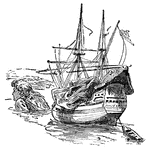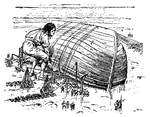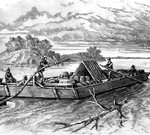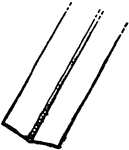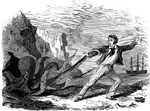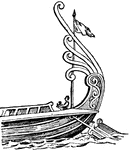
Destruction of Nashville
"Destruction of the famous Confederate privateer Nashville, in the Ogeechee River, Ga., by…

Steamer Alabama
"The Confederate privateer steamer Alabama (290). Captain Raphael Semmes. Our illustration…

Land Practice
"Land practice of sailors with the Dahlgren Howitzer Boat Gun, sponging out the gun."— Frank Leslie,…

Artillery Practice
"Artillery practice with the Dahlgren Howitzer boat gun- loading."— Frank Leslie, 1896

Artillery Practice
"Artillery practice with the Dahlgren Howitzer boat gun- officer giving the word of command to fire."—…

Quaker City
"The Quaker City, one of the Potomac Flotilla, engaging Confederate dragoons in Lynn Haven…
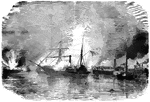
Harriet Lane
"Daring and desperate attack- surprise and capture of the United States gunboat Harriet Lane…

Fort Calhoun
"Fort Calhoun, on the ripraps, situated between Fortress Monroe and Sewell's Point, in Hampton Roads,…

Re-enforcements
"Re-enforcements for Grant's army leaving Memphis, Tenn. Our sketch shows the Alice Dean, a…

Che-Kiang
"The Banks Expedition- a Confederate Schooner running into the United States transport Che-Kiang,…

Commodore Barney
"The war in Virginia. Explosion of a torpedo under the Commodore Barney, on James River, August…
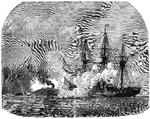
Mobile Harbor
"Farragut's naval victory in Mobile Harbor. The Hartford engaging the Confederate ram Tennessee.…

Weehawken
"The ironclad Weehawken returning to fire a parting shot at Fort Sumter, after the bombardment,…

Frog on board
As Gulliver rows in the miniature boat made for him by the Queen of Brobdingnag, a giant frog leaps…

Perry Transferring His Colors
"Perry transferring his Colors from the Lawrence to the Niagra."—E. Benjamin Andrews, 1895
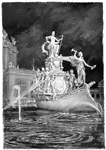
World's Fair
"The World's Fair at Chicago. Central portion of MacMonnies Fountain- effect of electric light."—E.…

spanish caravel
A Spanish caravel. The vessels furnished by Isabella were only caravels, light coasting ships,…

Clermont
The Clermont, Fulton's experiment boat, was constructed under the personal supervision of Fulton,…

Bloody Run
Bloody Run, a stream which comes leaping in sparkling cascades from the hills, and affords fine trout…
Long Point
Long Point and vicinity. This little sketch was taken from the steam-boat , near the south end of Long…

Roger's Rock
Roger's Rock. This sketch is from the lake, a little south of Cook's Point, seen just over the boat…
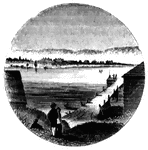
Chimney Point
Chimney Point Landing. This view is taken from the green in front of the inn at Chimney Point, looking…

Arnold's Battle
Scene of Arnold's naval battle. This sketch was made from the pilot's room of the steam-boat just after…

Isle Aux Noix
Isle Aux Noix, in the Sorel. The sketch was made from the pilot's room of the steam-boat, about half…
Cascades
The Cascades, on St. Ann's Rapids. These rapids are so called from the cirumstance that a village of…
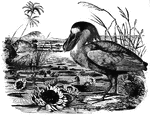
Boatbill
Also known as the crested savacou, the boat-bill gets its name from the shape of its beak, which resembles…
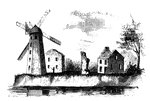
Wind-Mill Point
Wind-mill Point. This view was sketched from the steam-boat, when a little below the wind-mill, looking…
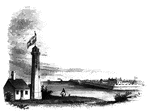
Fort Niagra
Distant view of Fort Niagra. This view is from the west side of the Niagra River, near the light-house.…

Society of the Cincinnati
"Society of the Cincinnati, member's certificate. This engraving is a fac simile of a certificate, about…

Red Gurnard
"Twelve to sixteen inches long; it feeds on curstaceous animals; spawns in May or June; it is esteemed…

Angler
"The fishing frog is three to five feet long. It has an enormous mouth, armed with numerous pointed…

Northern Charr
"A European species, and inhabits the northern lakes of England and those of Scotland; it is from one…

Ship
"Abox- in or into the position of the yards of a vessel when the head-sails are laid aback: applied…
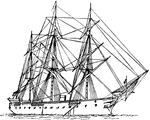
A-cockbill
"Nautical-with ends pointing upward. Image: Man-of-war with Yards a-cockbill."-Whitney, 1902

Acrostolium
"The stern of a ship, also the gunwale of a ship, the extremity of a ship's beak."-Whitney, 1902

Anchor Shackles
"The bow or clevis, with two eyes and a screwbolt, or bolt and key, which is used for securing a cable…

Boat Fly
"They carry the air required for their respiration in a space left for this purpose between the wings…
Electric Torpedo Boat
"Torpedo Boats are small vessels built for speed and fitted with tubes for firing torpedoes by either…
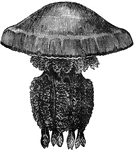
Rhizostoma cuvieri
"The Rhisostoma Cuvieri, a British species, measures two feet, or ever more, in diameter, while…

Knots and Splices
"Knots and splices include all the various methods of tying, fastening, and joining ropes or cords.…

Osprey
"The Osprey, the fish hawk, bald buzzard, or fishing eagle. A bird of prey, of almost world wide distribution…

Positions in Rowing
"Rowing is the propulsion of a boat by oars. The oarsman sits with his face to the stern of the boat,…
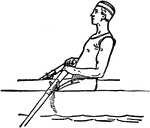
Positions in Rowing
"Rowing is the propulsion of a boat by oars. The oarsman sits with his face to the stern of the boat,…

